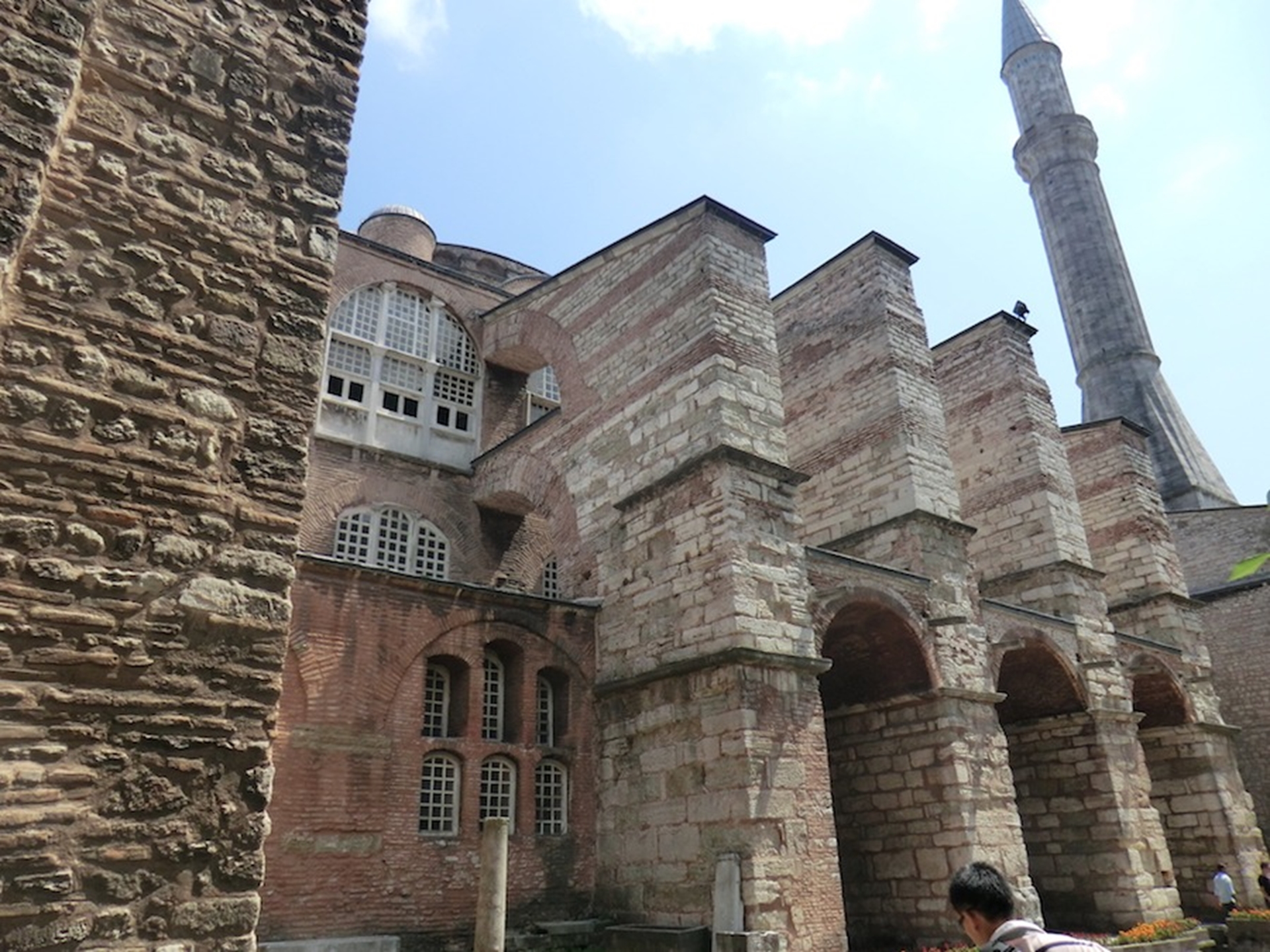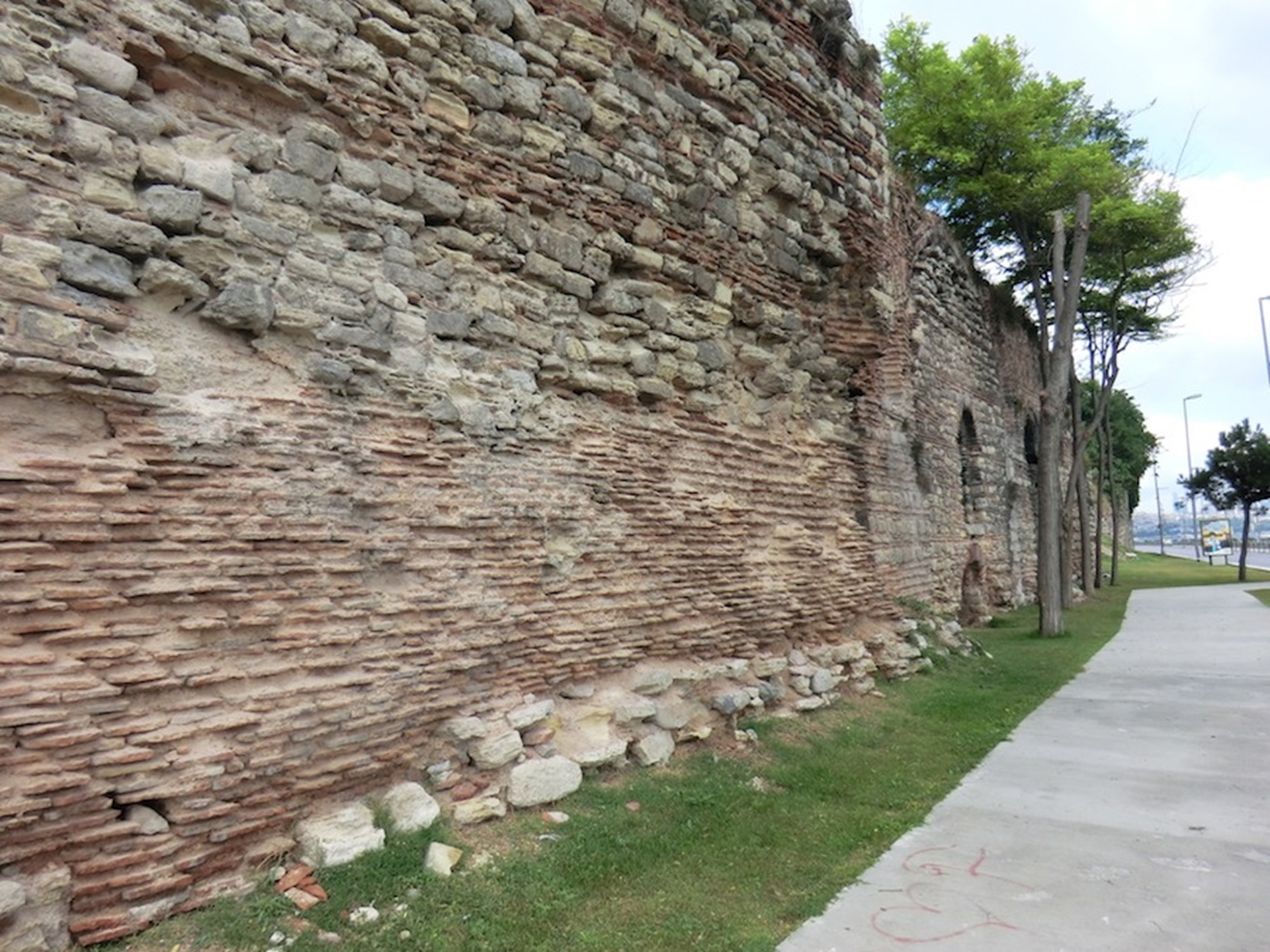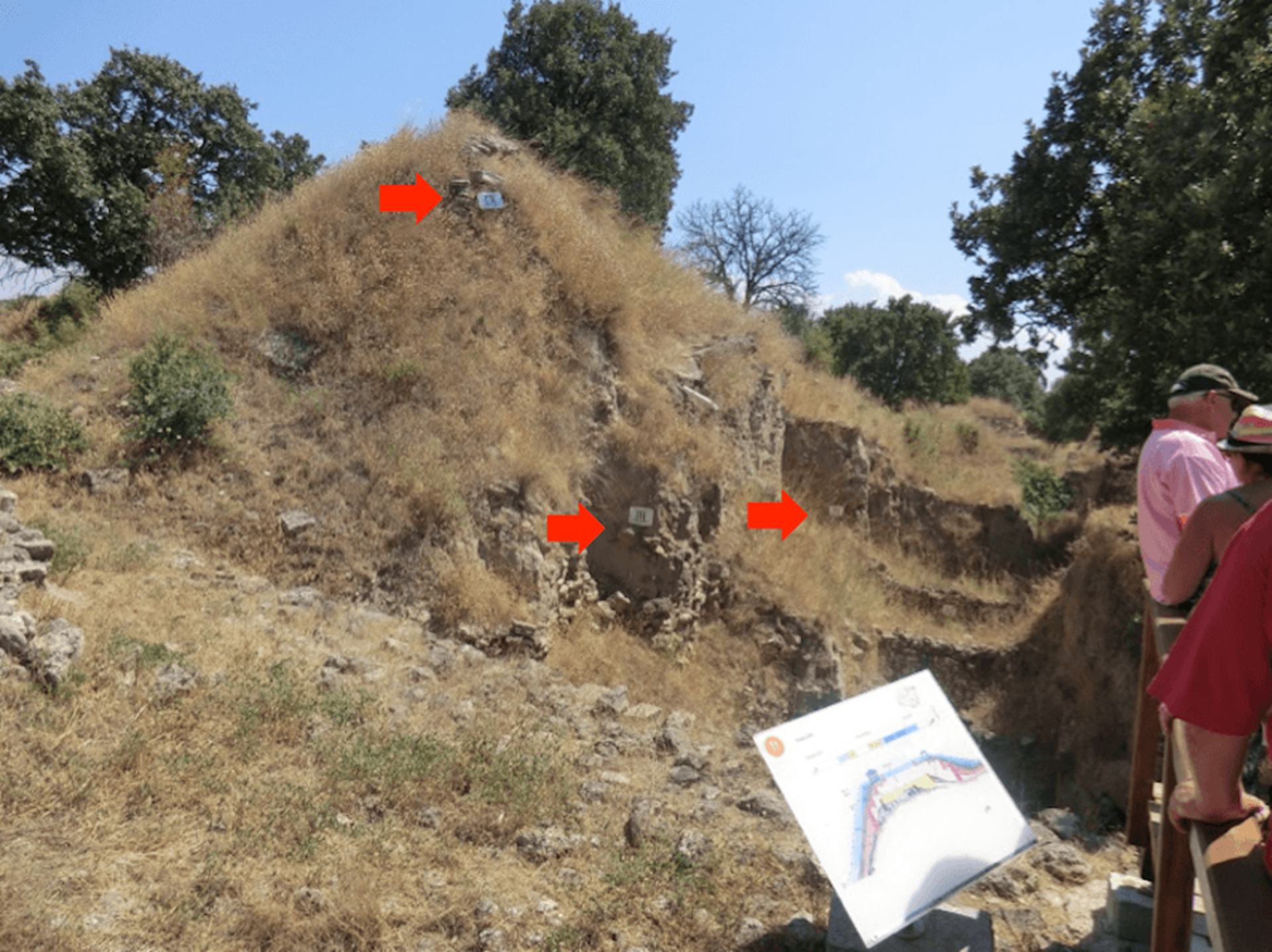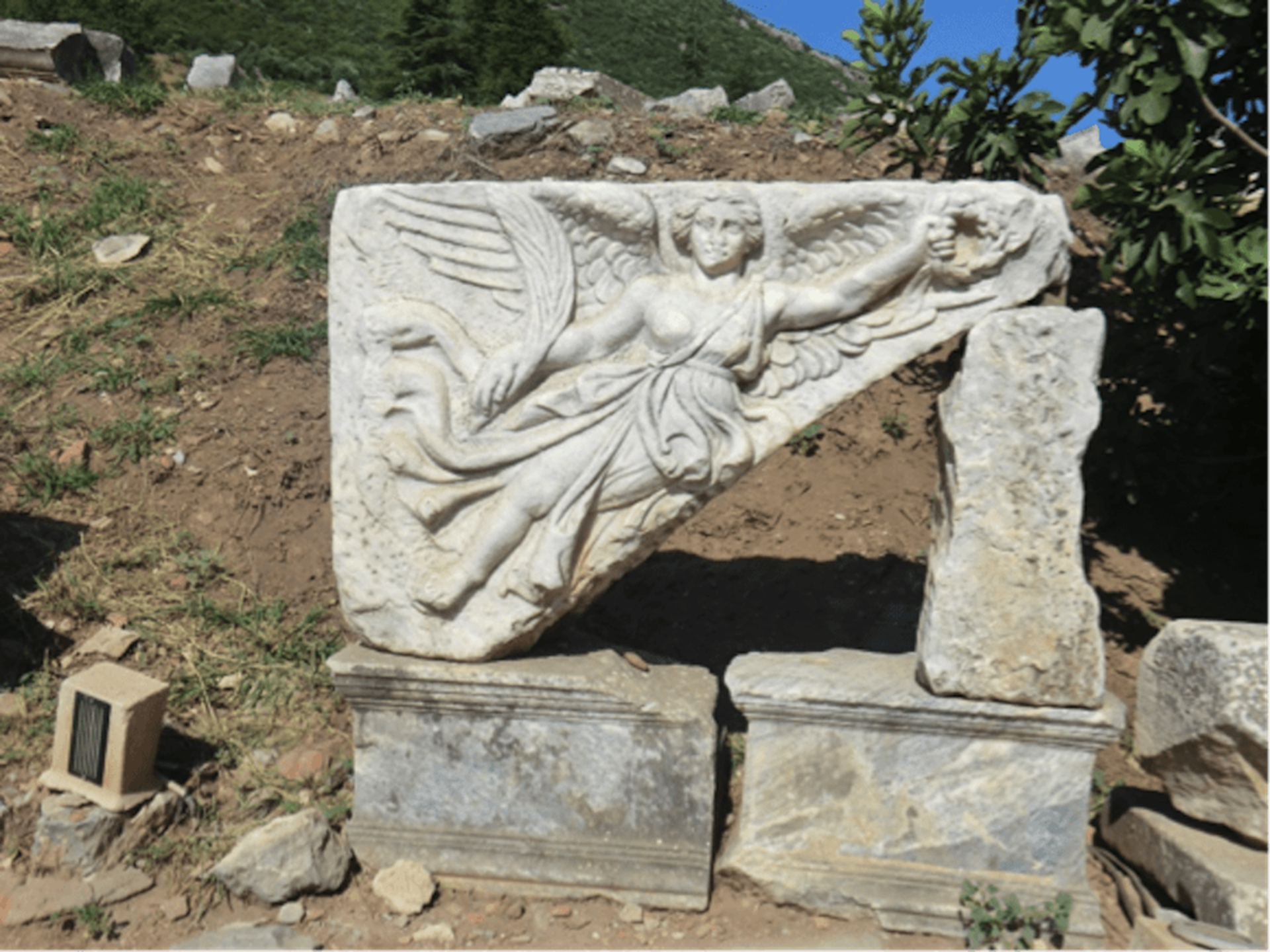Marvelous Masonry Turkey Celebrating Masonry’s Heritage
Words: David BiggsEditor’s Note: This unmodified edition of Marvelous Masonry originally ran in MASONRY Magazine. We hope you enjoy the historical information and specifics on architecture and construction provided by David Biggs as much as the readers of MASONRY did.
Last issue we visited Iraq. This time we’ll travel west to Turkey, a country created in the aftermath of World War I. Steeped in history from ancient cultures through the Ottoman Empire, Turkey has a wealth of historic sites. It should be no surprise that nearly all of Turkey’s historic sites are based upon masonry construction.
As a little history, modern Turkey came into existence in 1923 and ended over 600 years of being part of the Ottoman Empire. The map below shows the various locations we’ll visit in this article.

Figure 1 - Map of Turkey with sites we’ll visit are circled (credit blogspot.com)
Masonry is the dominant construction type for commercial and residential buildings in Turkey. There are high-rise steel and concrete frame buildings with glass curtain wall that can be found in any large city in the world. But, Turkey still has many low-rise buildings with concrete frame and masonry infill.
Turkey is a wealthy country is terms of history and monuments. It is also a country with large earthquakes. Often, that is a bad combination. Many magnificent monuments have been lost to earthquakes. The challenge Turkey faces is to conserve, preserve and restore their remaining built heritage for future generations.
While Ankara is the capital, Istanbul (1 on map) is the country's cultural, economic, and historic center. It has been known by many names including Byzantium and then Constantinople before becoming Istanbul. Founded in 660 BC, it was the capital of the Roman/Byzantine, Latin and Ottoman empires for most of the time period of 330 AD to 1923.
Today, Istanbul (Figure 2) is the world’s 7thmost populous city and is partially in Europe and part in Asia. According to the World Trade Organization, it ranks 6thas a world tourist destination. The historic center of Istanbul is also listed as a UNESCO World Heritage Site.


Figure 2 - Istanbul
No matter which way you turn, you see magnificent masonry construction. The Haga Sophia (c. 537 AD) is my favorite (Figure 3). Built in only six years, the massive domed structure was built as a Greek Orthodox cathedral. In 1432, it was converted to a mosque by the Ottomans. Then in 1935, it was made into a museum which it remains today.


Figure 3 – Hagia Sophia (c. 537)
The dome collapsed in 558 AD and was totally rebuilt with added stone buttressing. It has survived massive earthquakes since the reconstruction. The minarets were added by the Ottomans in the 1400s, one with red brick and the other three with limestone and sandstone. The building has been studied consistently over the past five decades and is constantly being worked on to conserve the structure.
The interior of the Hagia Sophia is so massive (180 ft tall) that the copper portion of the Statue of Liberty would fit inside easily (Figure 4). The construction is primarily brick faced in stone inside and out and having stone columns; the added buttresses are also stone construction (Figure 5). The initial dome was faulted for having more mortar than brick which weakened it and made it susceptible to the earthquake that destroyed it in 558 AD. The rebuilt dome was strengthened such that it has been cracked by subsequent earthquakes, but still stands. Both Christian and Islamic symbols adorn the walls.


Figure 4 – Interior of Hagia Sophia


Figure 5 – Stone buttresses with stone faced minaret in background
Another astonishing masonry structure in Istanbul is the Sultan Ahmed Mosque (1616 AD) is commonly referred to as the Blue Mosque (Figure 6). The blue reference is to the remarkable blue tiles of the interior (Figure 7). For a 3D view of the interior, see http://www.3dmekanlar.com/blue_mosque.htm. The mosque can hold 10,000 worshippers.
On these ancient structures, cleaning and conservation is an on-going process. In 2013, the back left minaret in Figure 6 was dismantled and rebuilt after it was discovered to be tilting over 2 inches; safety was a concern. Recently, a new three and a half year restoration was announced. This will be the most significant project undertaken since it was built nearly 500 years ago. The work will be performed and while leaving the mosque open for services and visitors.


Figure 6 – Blue Mosque (c. 1616)

Figure 7 – Interior of Blue Mosque
It would take days to see all the marvelous masonry of Istanbul. Figure 8 shows the Ottoman arches at Topkapi Palace (c. 1465 AD) which is behind the Hagia Sophia. The workmanship is truly marvelous with tight joints.


Figure 8 – Topkapi Palace Courtyard
Figure 9 shows a section of the walled city. The construction dates are unclear but most were built from the 8th to 15th centuries. This one is along the waterfront has an intermix of Roman brick with stone from previous repairs.

Figure 9 – Ancient walls of Istanbul
Figure 10 shows a more recent restoration and finest examples of a fortress sea wall. The banded brick was original and serves as header courses for the stone. The colored mortar is a recent embellishment. This wall type can be found on numerous walls throughout the Ottoman Empire.

Figure 10 – Restored wall
Leaving Istanbul, we travel to Ancient Troy on the west coast of modern Turkey (2 on map) just south of current day Çanakkale. However, it was once part of ancient Greece. To many people, the image of Ancient Troy is derived from the 2004 film “Troy” with Brad Pitt as Achilles. Visiting today, most would be surprised that the massive outer walls in the film were constructed and filmed in Cabo San Lucas, Mexico. Other scenes were filmed in Malta. The famed Trojan Horse from the movie was donated to Çanakkale and attracts many visitors.
Troy (a World Heritage site) actually had at least nine cities. War, fire, earthquakes and the desire for a larger city led to multiple constructions (Figure 11) built over each other.


Figure 11 - The many cities of Ancient Troy (credit salimbeti.com)
Walking the site today is quite confusing. Excavations have exposed portions of several cities. Not one is fully exposed. Figure 12 shows some of the major walls that are visible. Conservation efforts try to eliminate the biological growth within the walls that can cause stone displacement. These walls are mass gravity walls that have survived numerous earthquakes. The batter is beneficial to providing stability.

Figure 12 – Dry-laid wall at Ancient Troy
Figure 13 shows how Figure 11 is used at the site to help visitors interpret what part of what city they are seeing. Notice the signs (see arrows) that delineate the city designation.

Figure 13 – City designation at Ancient Troy
Figure 14 shows a conservation effort at Ancient Troy. Tent structures allow workers protection from the sun and minimize rain erosion on delicate construction that is uncovered. Much of the heritage construction is dry-laid stone or includes mud bricks and mud mortar. Preventing erosion is a high priority.

Figure 14 - Protection over excavated walls
Most historic sites are run by foreign missions. A foreign group funds and self-performs much of the work, but the Turkish government approves and controls their activities. The Troy site is currently overseen by German interests, but Americans have played a major part in archeological efforts over the past decades.
Moving on to Ephesus (3 on map), we find an ancient Greek city that came under Roman rule in 129 BC and is another World Heritage site. Both Greek and Roman ruins are everywhere. The Turkish and Austrian governments share in the restoration efforts. British archeologists began the work in 1869. Ephesus and the surrounding area is a must-see stop for Christian religious importance. Plan most of a day if you get to Ephesus; many cruise ships stop here.
Figure 15 shows the ornate marble façade of the Roman library dating to c.120 AD. The stone work was discovered in ruin and rebuilt. Figure 16 shows behind the façade. The wall is now free-standing even though site is in a seismic zone similar to or worse than southern California.

Figure 15 - Library at Ephesus


Figure 16 – The Rear of the Library
Figure 17 shows the graphic of the Library façade rebuilding. Steel reinforcement was drilled and grouted into the stone to provide strengthening. This is a common technique used throughout the world including the United States. However, many of the joints are “flexible”; the stones are intended to rock and absorb some of the seismic force during an earthquake.


Figure 17 – Reinforcement for strengthening
Everywhere you turn in Ephesus is a mason’s dream. Figure 18 shows part of the amphitheater that seats 22,500. The construction is brick and Roman concrete; a major reconstruction and restoration is underway. The tourists in the foreground are on the “stage”. The stones to the right are the remains of the stage house. Even in the open air, a speaker on stage can be heard in every seat.

Figure 18 – Roman amphitheater
Stone construction served many purposes in ancient times. No explanation is needed for Figure 19. The wealthy often paid someone or had a slave “warm the seat” for them before they arrived.

Figure 19 – Roman meeting room
Figure 20 is an amazing carving of the Greek Goddess of Victory, Nike, and the inspiration for the famous Swoosh that adorns Nike products.


Figure 20 – Nike, the Greek Goddess of Victory
Figure 21 shows one of the Roman arches nearby Ephesus. While Roman brick is large and thin, clearly the volume of mortar is greater than what would be used to build a modern-day masonry arch.

Figure 21 – Roman arch
Other amazing historical sites near Ephesus are the House of Virgin Mary, site of the Artemis Temple, the Basilica of St John, and more. All masonry structures!
Moving south toward the Mediterranean Sea, we come to Antalya (4 on map). Antalya is now a resort area and the regional center of numerous historic sites. Founded in the second century BC, it too has Roman, Byzantine, Seljukand Ottomaninfluences.
Our first stop is at ancient Myra (modern day Demre) which is southwest of Antalya. The Roman amphitheater (Figure 22) is the largest in the region. It was partially filled in by flooding and environmental effects but has been excavated and conserved. Archeologists have determined that an earthquake and tsunami in 141 AD destroyed much of the limestone and marble theater, but was shortly after rebuilt.


Figure 22 – Roman amphitheater in Myra
Ancient Perge (modern day Perga, northeast of Antalya) predates Alexander the Great and has the ruins of a Greek and Roman city with temple, baths, amphitheater and more (Figure 23). The main gate structure is being stabilized by a steel frame. External structures like the one shown are unusual in Turkey due to cost and the large number of historic structures that are in need. The columns of the market area (Figure 24) have all been reset as part of the restoration.


Figure 23 - Ancient Perge

Figure 24 – Partially restored columns
Figure 25 shows a portion of the Roman bath with the floor missing. The blow floor supporting arches and piers are still intact below the floor level. The below floor area would have contained heated water which warmed the arches and piers. The temperature of the bath area above was then heated by the thermal mass of the masonry below. So thousands of years ago, the Romans clearly understood the benefits of masonry and thermal mass.


Figure 25– Roman Bath in Perge
The arches at this site are amazing. Figure 26 shows how little masonry is needed for an arch to stay intact. It is likely to be destroyed during another earthquake. Figure 27 shows some excellent examples of intact arches. The stone work was set in mud mortar which has mostly eroded over time.


Figure 26 – Failing arch


Figure 27 – Intact arches
Figure 28 shows a theater that hosted sporting events. The sloped seating is built over vaults (Figure 29 is the rear of the seats in Figure 28) that were used for stabling houses.


Figure 28 – Sporting arena


Figure 29 – Stone vaults
From Perga, we travel to Side (southwest of Antalya) a Greek city founded in the 7thcentury BC. Figure 30 shows a restoration in progress. All the stones have been identified and sorted (see the various piles on left). The reconstruction includes several columns of the temple. The sections are drilled and pinned together without visible evidence of the work. The remainder of the columns will not be installed due to cost. However, the visitor gains a sense of size of the original temple from the limited reconstruction.

Figure 30 – Side Temple of Apollo
Nearby in Aspendos, there is the Greek theater from 155 BC which seats 12,000 (Figure 31). It is considered the best preserved amphitheater from antiquity. It was pillaged by the Romans and later used as a caravansee and the stage house was a palace. Following its restoration, a summer International Opera and Ballet Festival has been held here each summer since 1994.

Figure 31 – Aspendos Theater c. 155 BC
Our next visit in Turkey is to Gordion (5 on map) near modern day Yassihüyük, southwest of Ankara in central Anatolia. Gordion was the fortress city of King Midas from the Phrygian empire and the site of Alexander the Great cutting the Gordion Knot. It has been nominated as a World Heritage site.
Excavations have been underway since the 1950s under the direction of the University of Pennsylvania to undercover the city that had been buried for over 2,000 years (http://sites.museum.upenn.edu/gordion/). Figure 32 shows the entrance to the city in 2012. The approximately 33-foot high walls shown were part of the entrance. The walls were likely twice as high and formed the exterior walls of buildings. When originally constructed, the walls were covered with a mud plaster coating and lime white wash. The mud plaster has eroded since the walls were exposed in the 1950s.


Figure 32 – Entrance to the Early Phrygian city of Gordion
In 1999, an earthquake damaged the walls and a serious bulge developed in one wall (right side of Figure 33). Since 2014, a conservation program has been underway to remove and reset the wall stones in the area of the bulge. The limestone blocks were rough cut and dry laid c. 900 BC. The mud plaster filled the joints about 3 to 4 inches deep and gave the stones stability.


Figure 33 – Wall bulge visible
Figure 34 shows the 2016 conservation work underway. A heavy-duty scaffolding was installed in 2014 and 2015 that allows the stones to be stored up high (approximately 250 pound per square capacity on each of the top two levels). A lightweight aluminum gantry and hoist were installed for moving the stones of up to 3,500 pounds each. Beneath the scaffolding is a pebble mosaic covered road that was the main entrance into the city. It is protected by a one-foot layer of earth and a railroad tie mat to support the heavy-duty scaffolding.


Figure 34 – 2016 scaffolding and hoist
Figure 35 shows the facing stones in the bulge area during removal. The fill behind the walls is broken stone and earth. In Figure 36, a cracked facing stone (20 inches to 36 inches wide) is stood up on end and pinned with stainless steel rods and epoxy adhesive. The worker is one of four Italian conservators that are working with Turkish workers.


Figure 35 – Gordion wall removal


Figure 36 – Stone repair
Because the construction season is from mid-June to mid-August, the project started in 2014 will be completed in 2018. The facing stones will be reinstalled in 2017 with stainless steel anchors that will anchor them to the earthen fill behind. A lime-based mortar is being used to fill the joints because the mud plaster is not being reapplied. Voids in the earthen fill are being injected with a lime-based grout and the tops of the walls will be protected with a soft capping of membrane and plantings. Walls that are not being rebuilt will be pointed with lime-based mortar and the voids in the fill injected. The repair techniques are similar to what would be done in the United States. However, the materials are more difficult to obtain and the local workers need to be trained.
Finally, we go to Ankara. Following the fall of the Ottoman Empire, it became the capital of the republic. There are numerous masonry historic sites with Roman and Ottoman architectural influences. Figure 37 shows the citadel high on a lava outcropping which dates back prior to 1,000 AD. It was begun by the Galatians and completed by the Romans. Over the centuries, it has seen numerous repairs and modifications. Today following restorations, it houses restaurants shops and lodging in the original homes.


Figure 37 – Ankara Citadel
Our last stop is the Augustus Temple c. 20 BC (Figure 38). The interior walls hold the inscription of the history of the reign of Augustus, Rome’s first empire. The steel frame stabilization is meant to act as earthquake bracing. The supports are fitted with pads that won’t stain or scar the marble stones. To the right is the Hacı Bayram mosque built in the 2nd millenium AD.


Figure 38 – Augustus Temple c. 20 BC
Turkey has much more to offer in terms of masonry monuments, restorations and conservation projects. This article gives you a taste of the marvelous masonry heritage you’ll find in Turkey should you ever visit.
If you have any interesting restoration work you’d like to share with us, please email us at dkamys@staging1.masonrymagazine.com!
Words and Photos: David Biggs, PE, SE unless otherwise noted